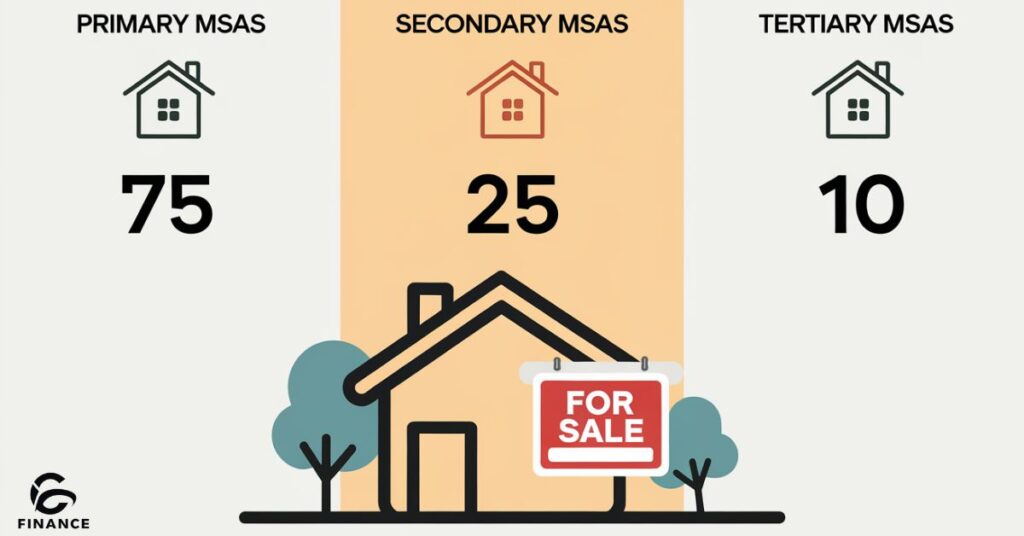Metropolitan Statistical Areas (MSAs) play a crucial role in real estate investment decisions. Many investors overlook the importance of MSAs, leading to missed opportunities and potential financial setbacks.
Without understanding MSAs, you risk investing in markets with limited growth potential or overlooking emerging hotspots. This comprehensive guide demystifies MSA real estate, exploring its types, benefits, and risks.
We’ll delve into how MSAs impact commercial financing, affect small business strategies, and influence tax implications. By the end, you’ll have the knowledge to make informed decisions in the dynamic world of MSA real estate.
History and Development of MSAs
The concept of Metropolitan Statistical Areas emerged in the 1950s. It aimed to define urban regions for statistical purposes. Over time, MSAs evolved to reflect changing urban landscapes. They now consider factors like population density and economic ties.
This evolution helps planners and investors understand urban growth patterns better. Today, MSAs play a crucial role in shaping real estate markets across the United States.
Characteristics of MSA Real Estate Markets
Real estate in Metropolitan Statistical Areas has unique features. These markets often have higher property values and faster price changes. They typically offer a mix of residential and commercial properties. MSA real estate markets are usually more competitive.
They tend to attract more investors and developers. These areas often see quicker adoption of new housing trends. Understanding these characteristics is key for anyone involved in urban property markets.
Types of MSAs in Real Estate

Not all Metropolitan Statistical Areas are the same. They come in different sizes and economic strengths. The main types are primary, secondary, and tertiary MSAs. Each type has its own real estate dynamics. Understanding these categories helps investors make smarter choices. It also aids in predicting market trends and potential growth areas. Recognizing MSA types is crucial for effective real estate market analysis.
Primary MSAs
Primary Metropolitan Statistical Areas are the largest urban centers. They include cities like New York, Los Angeles, and Chicago. These areas have vast, diverse real estate markets. They offer a wide range of property types and investment opportunities.
Primary MSAs often lead in new real estate trends. They typically have higher property values and more international investors. Understanding primary MSAs is key for large-scale real estate investments.
Secondary and Tertiary MSAs
Secondary and tertiary Metropolitan Statistical Areas are smaller than primary ones. They include cities like Austin, Nashville, and Raleigh. These markets often offer better growth potential. They typically have lower entry costs for investors.
Secondary and tertiary MSAs can provide good returns with less competition. They’re becoming increasingly popular among savvy real estate investors. These areas often show strong job growth and improving quality of life.
Micropolitan Statistical Areas
Micropolitan Statistical Areas are the smallest type of MSA. They typically have populations between 10,000 and 50,000. These areas offer unique real estate opportunities. They often have lower property costs and less competition.
Micropolitan areas can provide good returns for patient investors. They’re worth considering for those looking beyond big cities. These markets can be more stable during economic downturns.
The Importance of MSAs in Commercial Real Estate
Metropolitan Statistical Areas greatly influence commercial real estate decisions. They provide crucial data on population, income, and economic trends. This information helps investors choose profitable locations.
MSAs affect property values and rental rates. They guide decisions on new developments and renovations. Understanding MSA data is vital for success in commercial real estate. It helps predict future market performance and demand.
Economic Indicators and MSAs
Economic indicators in Metropolitan Statistical Areas are vital for real estate analysis. They include factors like job growth, GDP, and income levels. These indicators help predict property demand and values.
They guide investment decisions and development plans. MSA economic data reveals market strengths and weaknesses. It helps investors spot emerging opportunities and potential risks. Understanding these indicators is crucial for making informed real estate choices.
Population Dynamics in MSAs
Population changes in Metropolitan Statistical Areas greatly affect real estate markets. Growth can drive up property values and rents. Decline might lead to market stagnation. Age distribution impacts housing demand and preferences.
Migration patterns influence neighborhood development. Understanding these dynamics helps predict future market trends. It’s crucial for long-term real estate investment strategies. Population data guides decisions on property types and locations.
Business Concentration and MSAs
Business clusters in Metropolitan Statistical Areas strongly impact real estate values. Areas with high business concentration often see increased property demand. This can lead to higher rents and property prices.
Business hubs attract more workers, boosting residential demand nearby. They can spark development of supporting businesses and services. Understanding business concentration helps predict future hot spots. It’s key for commercial and residential real estate investments.
MSA Real Estate Investment Benefits
Investing in Metropolitan Statistical Area real estate offers several advantages. These markets often provide better liquidity and value appreciation. They typically have a wider range of investment options.
MSA properties can offer higher rental yields in some cases. These areas usually have better infrastructure and amenities. They often attract a steady stream of new residents and businesses. MSA investments can provide good long-term growth potential.
Diversification Opportunities
Metropolitan Statistical Areas offer great ways to spread real estate investments. They provide various property types in one region. Investors can mix residential, commercial, and industrial properties. This variety helps balance risk and potential returns.
MSAs allow investment across different neighborhoods and submarkets. They offer options for different budget levels and risk appetites. Diversifying within an MSA can lead to more stable overall returns.
Potential for Higher Returns
Real estate in Metropolitan Statistical Areas can offer strong returns. Growing MSAs often see faster property value increases. They can provide higher rental incomes in popular areas. Some MSAs offer better yields than national averages.
Fast-growing industries in MSAs can boost property demand. This can lead to better capital appreciation over time. However, higher returns often come with increased competition and entry costs.
Infrastructure and Amenities
Well-developed infrastructure in Metropolitan Statistical Areas boosts real estate value. Good transportation systems make properties more desirable. Quality schools and healthcare facilities attract residents.
Parks and cultural venues enhance neighborhood appeal. Modern utilities and internet connectivity are increasingly important. These factors can lead to higher property values and rents. They also contribute to long-term market stability and growth potential.
Risks Associated with MSA Real Estate Investment

Investing in Metropolitan Statistical Area real estate has its challenges. Market volatility can be higher in some MSAs. Overvaluation is a risk in rapidly growing areas. Some MSAs face issues like oversupply or changing demographics.
Economic downturns can hit certain MSAs harder than others. Regulatory changes can impact property values and development. Understanding these risks is crucial for making informed investment decisions.
Market Volatility
Real estate markets in Metropolitan Statistical Areas can be volatile. Economic shifts can cause rapid price changes. Job market fluctuations greatly impact property demand. Population changes can quickly affect housing needs.
Investor sentiment can lead to market swings. Some MSAs are more stable, while others see frequent ups and downs. Understanding this volatility is key for timing investments and managing risk.
Overvaluation Concerns
Some Metropolitan Statistical Areas face risks of real estate overvaluation. Rapid price growth can create market bubbles. This is often seen in popular, fast-growing MSAs. Overvaluation can lead to sudden market corrections. It poses risks for both buyers and sellers. Investors should watch for signs of unsustainable price increases. Careful market analysis helps avoid overpaying in overheated markets.
Regulatory and Zoning Challenges
Metropolitan Statistical Areas often have complex real estate regulations. Zoning laws can limit development options. Building codes may increase construction costs. Some MSAs have strict tenant protection laws.
Others impose rent control or affordable housing requirements. These regulations can impact investment returns. Understanding local rules is crucial for successful MSA real estate investing. It helps avoid legal issues and unexpected costs.
How MSAs Impact Commercial Financing
Metropolitan Statistical Area classification affects commercial real estate financing. Lenders often view MSA properties differently. Loan terms can vary based on MSA characteristics. Some MSAs are seen as lower risk, leading to better loan conditions.
Others might face stricter lending criteria. MSA economic data influences lenders’ decisions. Understanding these impacts is crucial for securing favorable financing.
Lender Perspectives on MSAs
Lenders view Metropolitan Statistical Area real estate through specific lenses. They assess MSA economic health and growth potential. Population trends and job markets are key factors. Lenders may favor certain MSA types for different property classes.
They often have different risk assessments for various MSAs. This affects loan approval rates and terms. Understanding lender perspectives helps in preparing stronger loan applications.
Loan Terms and MSA Classifications
Metropolitan Statistical Area classifications can influence real estate loan terms. Prime MSAs often get more favorable interest rates. Loan-to-value ratios may vary based on MSA type. Some lenders offer special programs for certain MSA categories.
Repayment periods might differ across MSA classifications. Understanding these variations is key for optimal financing. It helps in comparing loan offers and negotiating better terms.
Risk Assessment in MSA Financing
Lenders carefully assess risks when financing Metropolitan Statistical Area properties. They analyze local economic indicators and trends. Population stability and growth projections are crucial factors. Job market diversity and strength play a big role.
Property market conditions within the MSA are closely examined. Understanding this assessment process helps in presenting stronger loan applications. It also aids in selecting properties with better financing potential.
MSAs and Small Business Real Estate Financing
Metropolitan Statistical Areas significantly impact small business real estate options. They influence both buying and leasing decisions. MSA classification can affect loan availability and terms. It impacts the choice between leasing and purchasing.
Location within an MSA is crucial for business success. Understanding MSA dynamics helps in making cost-effective property decisions. It’s key for aligning real estate choices with business goals.
SBA Loans and MSA Considerations
Small Business Administration loans consider Metropolitan Statistical Area factors. SBA programs may have different terms for various MSA types. Some MSAs qualify for special SBA incentives. Loan limits can vary based on MSA classification.
The SBA considers local economic conditions in loan approvals. Understanding these nuances helps in leveraging SBA loans effectively. It can lead to better financing options for small businesses.
Lease vs. Buy Decisions in MSAs
Metropolitan Statistical Area characteristics influence lease versus buy decisions. Property values and trends vary across MSAs. Rental rates differ between MSA types. Some MSAs offer better long-term ownership benefits.
Others might favor leasing due to market volatility. Understanding these factors helps in making cost-effective choices. It’s crucial for aligning real estate decisions with business strategies.
Location Strategy for Small Businesses in MSAs
Choosing the right location within a Metropolitan Statistical Area is crucial. It affects customer access and employee commutes. Different areas within an MSA offer varied benefits. Some locations provide better visibility and foot traffic.
Others offer lower costs or room for expansion. Understanding MSA submarket dynamics is key. It helps in finding the best balance of cost and opportunity.
Read This Blog: GoMyFinance Invest: Top 5 Strategies for Maximizing Your Returns
Tax Implications of Investing in MSA Real Estate
Metropolitan Statistical Area investments come with specific tax considerations. Property tax rates can vary significantly between MSAs. Some areas offer tax incentives for certain types of development.
Capital gains treatment may differ based on MSA characteristics. Understanding these tax implications is crucial for accurate investment analysis. It helps in maximizing after-tax returns on MSA real estate investments.
Property Tax Variations Across MSAs
Property taxes can vary widely across Metropolitan Statistical Areas. Some MSAs have higher rates due to better services. Others offer lower rates to attract development. Tax assessment methods may differ between MSAs.
Some areas provide tax breaks for specific property types. Understanding these variations is crucial for accurate cost projections. It helps in comparing true costs of properties across different MSAs.
Tax Incentives for MSA Development
Many Metropolitan Statistical Areas offer tax incentives for real estate development. These can include tax abatements or credits. Some MSAs target specific types of development or areas. Incentives may aim to encourage affordable housing or commercial growth.
They can significantly impact investment returns. Understanding available incentives helps in identifying lucrative opportunities. It’s key for maximizing the financial benefits of MSA investments.
Capital Gains Considerations in MSA Real Estate
Capital gains tax treatment can vary in Metropolitan Statistical Area investments. Holding periods may affect tax rates differently across MSAs. Some areas offer special capital gains treatment for certain properties.
Understanding these nuances is crucial for tax planning. It helps in timing property sales for optimal tax outcomes. Proper planning can significantly impact overall investment returns in MSAs.
Also Read: Unlocking the Potential of STR MEANING Real Estate: A Comprehensive Guide
Future Trends in MSA Real Estate
Metropolitan Statistical Area real estate markets are constantly evolving. Technology is reshaping urban living and working spaces. Sustainability is becoming a key factor in development. Post-pandemic shifts are changing property use patterns.
Some MSAs are seeing increased demand for flexible spaces. Others are adapting to new remote work trends. Understanding these trends is crucial for forward-looking investments.
Technology and Smart Cities Impact
Technology is transforming Metropolitan Statistical Area real estate markets. Smart city initiatives are enhancing urban living quality. IoT devices are improving building efficiency and management. Tech hubs are creating new property demand hotspots.
Digital infrastructure is becoming as important as physical structures. Understanding these tech trends is key for future-proofing investments. It helps in identifying emerging opportunities in MSA real estate.
Sustainability and Green Building in MSAs
Sustainability is reshaping Metropolitan Statistical Area real estate landscapes. Green building practices are becoming standard in many MSAs. Energy-efficient properties are seeing increased demand.
Some areas offer incentives for sustainable development. Green certifications can boost property values and attract tenants. Understanding this trend is crucial for long-term investment strategies. It helps in aligning properties with growing environmental concerns.
Key Takeaways for MSA Real Estate Investors
Successful Metropolitan Statistical Area real estate investment requires careful analysis. Understanding MSA classifications and characteristics is crucial. Economic indicators and population trends greatly impact markets.
Financing options and tax implications vary across MSAs. Future trends like technology and sustainability are reshaping opportunities. Careful risk assessment and market research are essential. Staying informed about MSA dynamics is key to making smart investment decisions.
FAQ
What defines an MSA in real estate terms?
An MSA is a region with a core urban area of 50,000+ people. It includes the core city and surrounding counties with strong economic ties.
How do MSAs affect property values?
MSAs influence property values through economic activity and population density. Larger, growing MSAs often see higher property values due to increased demand.
Are all MSAs equally good for real estate investment?
No, MSAs vary in investment potential. Factors like economic growth, job market, and population trends make some MSAs more attractive than others.
What are the main differences between investing in primary vs. secondary MSAs?
Primary MSAs often have higher prices and more competition. Secondary MSAs may offer better growth potential and lower entry costs for investors.
How often are MSA classifications updated?
The Office of Management and Budget updates MSA classifications every 10 years. Minor revisions may occur between major updates.
Can a property be part of multiple MSAs?
No, a property is typically assigned to only one MSA. However, some areas may be part of a Combined Statistical Area (CSA) that includes multiple MSAs.
How do MSAs influence commercial real estate trends?
MSAs shape commercial real estate trends through economic indicators, population growth, and business concentration. These factors affect demand for office, retail, and industrial spaces.
What resources are available for researching MSA real estate markets?
Resources include government databases, real estate market reports, local economic development offices, and professional real estate associations.
Conclusion
Understanding MSA real estate is key for smart property investments. These areas offer unique opportunities and challenges. They shape market trends and property values. Investors should study MSA types, economic indicators, and future trends.
This knowledge helps in making informed decisions. Remember, each MSA is different. What works in one may not work in another. Stay informed and adapt your strategy to each MSA’s specific characteristics. With careful research, MSA real estate can be a rewarding investment path.

Howdy, editor at FinanceEon.com, brings over a decade of financial journalism experience. He ensures accuracy and insightful analysis, guiding a team on market trends and investment strategies.







